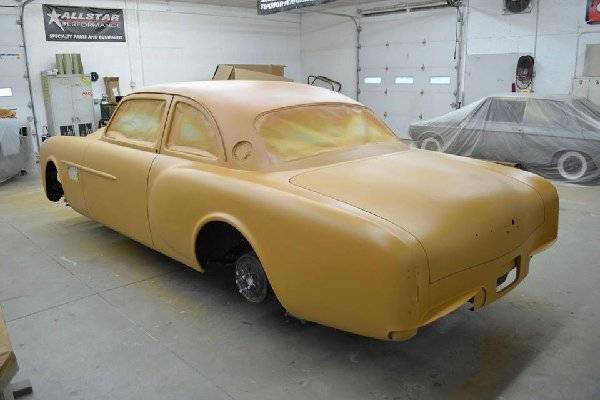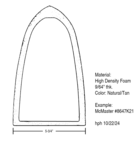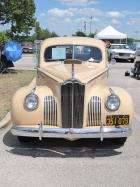|
Re: 1952 327 Connecting Rod Help/Suggestions
|
||||
|---|---|---|---|---|
|
Home away from home
|
Suppose it depends on the final drive ratio and what sort of revs you want to be able to see. If you were to use a normal Packard overdrive trans with the usual 4.10 rear, 80 mph is only about 3000 rpm. That puts the stress on the rods at only 56% of what they would see at the the engine's normal rated 4000 rpm. Even if you kick it down at that speed its still only 4050 or so.
Those cars will pull a right fair hill at 80 stock. With your reduced front area and increased breathing there will be no particular need for extra high revs to maintains the speeds you mention. Those rods are on the long side so if you want really high revs I'd probably go for custom made. In my own cars I just sand off all the die flash and any sharp points before weight matching and straightening. But then, I am not a fan of high revs; don't like the sound of screaming engines. Thundering yes, screaming no. The nice thing about I8s is that they are so easy to balance with simple tools. Certainly would have the factory balance on the crank checked though.
Posted on: 2018/12/23 7:45
|
|||
|
||||
|
Re: 1952 327 Connecting Rod Help/Suggestions
|
||||
|---|---|---|---|---|
|
Home away from home
|
Sounds like a neat project. Hope you post more pictures as you go along.
John
Posted on: 2018/12/23 8:47
|
|||
|
||||
|
Re: 1952 327 Connecting Rod Help/Suggestions
|
||||
|---|---|---|---|---|
|
Not too shy to talk

|
Thanks Ross. I really didn't think of that (final drive ratio). I am going custom in that department as well - let me get back to you - but I'm pretty sure it's a looong final drive. It's a late 60's Impala 12-bolt rear-end. I'm building this car for mid-range power as a highway cruiser - I have sports cars for the back roads!
Again, the rods look to be in great shape and the pins and bearings were all nice and smooth with no real wear that I could see. Perhaps the idea of just cleaning them up to get the hard edges of the castings is a good start. I bought the car as a stalled project from someone in New Mexico who had partially built up the car for the Carrera recreation in Mexico. BTW - I'm glad you replied (I've been a lurker here for about a year and I know your rep.). I had a chance to get your attention at Hershey a couple years back next to Ralph's speedster, but I got sidetracked. Promise - I'm not a stalker! I've wanted to do this project for about five years now and when I did some further digging after I bought the car from NM, I saw your car...I hope we can get them together someday - I'm in Pittsburgh and my folks live closer to Central PA. best- Wes
Posted on: 2018/12/23 9:21
|
|||
|
-Willie Paul
52 Packard 200 Coupe "La Carrera" tribute 26 Packard 136" chassis with 29 HP Eight engine 62 Triumph TR4 roadster custom 95 Ferrari 456 GT manual 70 BMW r75/5 "scrambler" 04 Mercedes g500 |
||||
|
||||
|
Re: 1952 327 Connecting Rod Help/Suggestions
|
||||
|---|---|---|---|---|
|
Not too shy to talk

|
Update: it is a 1969 Impala 12-bolt rear end. It has a final drive ratio of 2.73
Posted on: 2018/12/23 10:01
|
|||
|
-Willie Paul
52 Packard 200 Coupe "La Carrera" tribute 26 Packard 136" chassis with 29 HP Eight engine 62 Triumph TR4 roadster custom 95 Ferrari 456 GT manual 70 BMW r75/5 "scrambler" 04 Mercedes g500 |
||||
|
||||
|
Re: 1952 327 Connecting Rod Help/Suggestions
|
||||
|---|---|---|---|---|
|
Forum Ambassador
|
Am curious if there would be an advantage or disadvantage using a 9 main 327 vs the 5 main in an application where higher revs are wanted. Logically one would think a 9 main crank and lower end support design would be more robust and take more stress but would the extra bearing surface be a disadvantage in some other respect?
Posted on: 2018/12/23 10:10
|
|||
|
Howard
|
||||
|
||||
|
Re: 1952 327 Connecting Rod Help/Suggestions
|
||||
|---|---|---|---|---|
|
Home away from home

|
FWIW, connecting rods usually fail from inertial forces. To help rods survive, keep the RPM low and use light weight forged pistons.
Have the rods professionally reconditioned so the big ends are round and the center-to-center length is the same. Quote: (let's assume no decking required) You must have your reasons for choosing Stromberg 97s for your carbs, but those are not what I'd recommend to be pressurized. The Stromberg WW, as used on the supercharged '57 - '58 Studebaker Golden Hawk, Packard Hawk and '57 Packards would be my choice. As to the question of the 5-main versus 9-main block choice, there have been so few supercharged endurance racing Packard I8s built, the experiences are not numerous. However, it's difficult to argue against a stronger bottom end. jack vines
Posted on: 2018/12/23 10:57
|
|||
|
||||
|
Re: 1952 327 Connecting Rod Help/Suggestions
|
||||
|---|---|---|---|---|
|
Home away from home
|
My preference for a five main is based on one fact and one surmise based on a fact:
The fivers have plenty of bearing area already compared to their power, the other 4 will only add drag. The niners in 51-54 were all equipped with a whomper stomper humongous vibration damper. I surmise from this that because of the extra bends and cheeks the cranks were not as torsionally rigid as the fivers. My guess is that the sales department specified nine mains and not engineering. In driving I have never been able to discern a difference. One other rather important item. Looking at the block that I cross sectioned (perhaps someone can find the picture?), there is a nice benefit to be gained by relieving the block between the intake port and the cylinder as the tilted valve causes a right fair hump for the mixture to cross. However I would not be brave enough to fit larger intake valves as the port wall is less than 1/8" thick just below the valve seat. Just carefully smooth out the humps and bumps there for a good effect.
Posted on: 2018/12/23 20:35
|
|||
|
||||
|
Re: 1952 327 Connecting Rod Help/Suggestions
|
||||
|---|---|---|---|---|
|
Forum Ambassador

|
Is this the one, Ross?
Attach file:  (51.60 KB) (51.60 KB)
Posted on: 2018/12/23 21:00
|
|||
|
||||
|
Re: 1952 327 Connecting Rod Help/Suggestions
|
||||
|---|---|---|---|---|
|
Home away from home
|
Yes, Owen, thanks. Note how thin the wall of the valve pocket is on the left. That is an intake port.
Posted on: 2018/12/24 8:07
|
|||
|
||||








